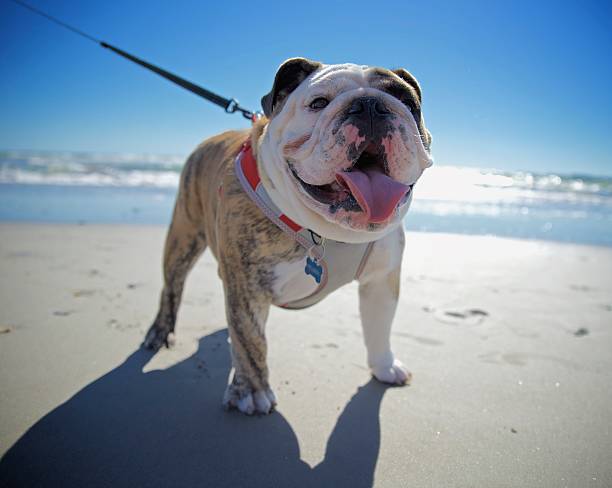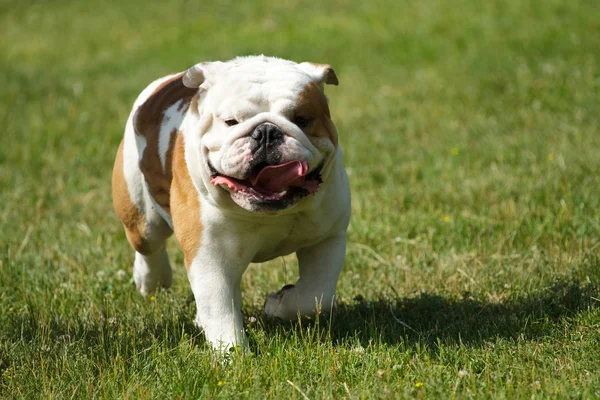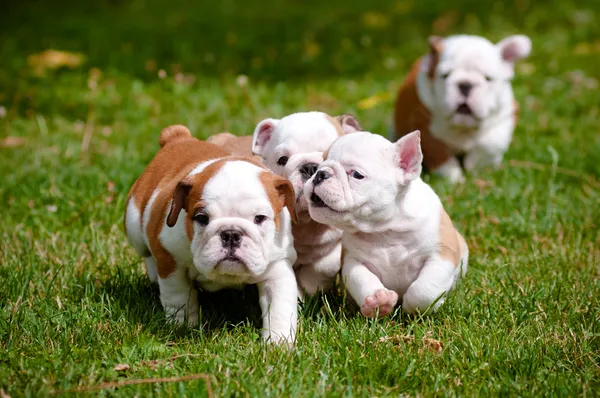The English Bulldog, an iconic symbol of determination and charm, holds a special place in the hearts of dog lovers and families worldwide. With its storied history, unmistakable appearance, and endearing personality traits, this breed has firmly established itself as a beloved companion and symbol of British tenacity.

| Category (Explanation) | Breed Information |
|---|---|
| Year of Breed Conception | 1940s-1950s |
| Country of Origin | United States |
| Weight (Male) | 75-120 lbs (34-54 kg) |
| Weight (Female) | 60-100 lbs (27-45 kg) |
| Coat Type | Short |
| Color Variations | White with patches of brindle, red, or brown |
| Shedding Level (Low, Moderate, High) | Moderate |
| Height (cm & in) | 20-28 inches (51-71 cm) |
| Breed Size | Large |
| Trainability (Low, Moderate, High) | Moderate |
| Mental Needs (Low, Moderate, High) | Moderate |
| Intelligence Level (Low, Moderate, High) | Moderate |
| Energy Level (Low, Moderate, High) | Moderate |
| Agility (Low, Moderate, High) | Moderate |
| Loyalty (Low, Moderate, High) | High |
| Playfulness (Low, Moderate, High) | Moderate |
| Exercise Needs | Regular exercise and playtime |
| Guarding Proficiency (Low, Moderate, High) | Moderate |
| Sociability with Children (Low, Moderate, High) | High |
| Barking Level (Low, Moderate, High) | Moderate |
| Digging Tendency (Low, Moderate, High) | Moderate |
| Destructive Behavior (Low, Moderate, High) | Low |
| Drooling Level (Low, Moderate, High) | Low |
| Obedience Level (Low, Moderate, High) | Moderate |
| Apartment Friendly (Yes/No) | Can adapt to apartment living |
| Inherent Prey Drive | Moderate |
| Physical Risk to Others (Low, Moderate, High) | Low |
| Travel Fatality Risk (Low, Moderate, High) | Low |
| Allergen Potential | Low (considered hypoallergenic) |
| Health Concerns (List of Common Health Concerns) | Hip Dysplasia, Skin Issues, Eye Problems, ACL Injuries |
| Average Life Expectancy (Life Expectancy in Years) | 10-16 years |










































































Woof Mastery is reader supported and our articles may contain affiliate links.
Instead of running third party ads that we have no control of we only use links from high-quality companies we are directly partnered with. Making use of these links come at no cost to you our reader, and in many cases have the extra benefit of discounted rates or sign up bonuses.
If you’re interested you can read more about our affiliate policy here.
We appreciate your support and always insure that the products and services we recommend are high-quality, helpful and relevant to the subject at hand!
The English Bulldog’s history is a captivating journey that transports us to medieval England. These remarkable dogs were initially bred in the 13th century for the brutal sport of bull-baiting. Their unyielding determination and powerful jaws made them formidable opponents.
However, as bull-baiting declined in the 19th century, breed enthusiasts embarked on a mission to preserve the breed itself. Through careful selective breeding, they retained the Bulldog’s distinctive appearance and cultivated its gentle temperament.
The transformation from a ferocious bullfighter to an iconic symbol of British resilience is an awe-inspiring testament to their enduring spirit. Today, English Bulldogs are adored worldwide for their undeniable charm and unwavering loyalty, embodying the strength and charisma of their storied past.

What sets the English Bulldog apart is its distinctive and endearing appearance combined with a gentle and friendly temperament. Their iconic wrinkled face, pushed-in nose, and loose skin make them instantly recognizable and utterly charming.
Despite their somewhat intimidating appearance, English Bulldogs are known for their affectionate nature, making them excellent companions. Their blend of a unique look and a heart full of love makes the English Bulldog truly special.
The English Bulldog’s traditional role dates back to bull-baiting, but it has evolved into a loyal and gentle companion. They excel as affectionate family pets, offering unwavering loyalty and a calm, easygoing nature.
English Bulldogs are renowned for their easygoing and docile nature. They exhibit a calm and friendly temperament, making them great companions.
They are affectionate, dependable, and make excellent family pets due to their gentle disposition. These dogs are not overly energetic, which can be a plus for families seeking a more laid-back canine companion. They enjoy lounging with their loved ones and are known for their loyalty and willingness to snuggle with their humans.
English Bulldogs tend to get along well with children and other pets, making them an ideal choice for a family looking for a loving and low-maintenance pet. English Bulldogs are also characterized by their distinct appearance, with loose, wrinkled skin, and a pushed-in nose that gives them a unique, endearing charm. Their expressive faces often reveal their emotions, making it easy for their owners to understand and connect with them.
English Bulldogs are celebrated for their calm, gentle, and dignified temperament. They typically exhibit unwavering loyalty and affection toward their families.
While their protective instincts are generally mild, they may display a vigilant nature, necessitating proper training and socialization to avoid overprotectiveness or aggression towards strangers. Occasionally, they may demonstrate territorial behavior and occasional stubbornness, emphasizing the need for consistent and patient training methods. Due to their moderate size, leash training is relatively manageable.
Despite occasional stubbornness, they are generally easygoing, making them exceptional companions for families and individuals alike. Their low energy levels and desire for close human interaction contribute to their reputation as loving and devoted pets.
English Bulldogs, often affectionately called Bulldogs, are medium-sized dogs known for their distinctive and lovable appearance.
They possess a square-shaped head with a broad, well-defined jaw and prominent cheeks, which contribute to their iconic and endearing expression.
Their eyes, typically dark and round, radiate warmth and charm, reflecting their gentle and soulful nature.
Ears are small and may fold over, adding to their unique charm. One of the most distinguishing features of English Bulldogs is their loose, wrinkled skin and a short, dense coat.
The coat can be found in various colors, including brindle, fawn, or white with patches. This coat not only enhances their characteristic appearance but also highlights their well-muscled and sturdy frame.
English Bulldogs possess a thick neck, leading to a broad chest and sturdy, straight legs. Their tail is often short and curled, which further adds to their distinctiveness.
In terms of size, males typically stand around 14 to 15 inches (36-38 cm) at the shoulder, and females are slightly smaller. Weight generally ranges from 40 to 50 pounds (18-23 kg).
Overall, English Bulldogs are widely recognized for their comical and gentle appearance. Their appearance exudes a delightful blend of strength, friendliness, and an undeniably adorable demeanor, making them a beloved breed among dog enthusiasts.
English Bulldogs exhibit a variety of color variations that contribute to their charming appearance. The most common color varieties for English Bulldogs include:
English Bulldogs have a low shedding level. They are not heavy shedders, and their shedding is typically minimal year-round. Regular grooming can help manage shedding by removing loose fur and promoting a healthier coat. Brushing your English Bulldog once or twice a week with a soft bristle brush can help keep shedding under control.
Factors that can affect shedding in English Bulldogs include genetics, overall health, and diet. Ensuring your Bulldog has a balanced diet with proper nutrients can contribute to a healthier coat and potentially reduce shedding.
English Bulldogs have short, dense coats that lie close to their skin. This short coat is relatively easy to maintain and does not require extensive grooming.
Brushing: Regular brushing, about once or twice a week, is usually sufficient to keep their coat healthy and minimize shedding. A bristle brush or a deshedding tool can help remove loose fur and distribute natural oils for a shiny coat.
Bathing: English Bulldogs do not require frequent baths unless they get exceptionally dirty. Over-bathing can strip their skin of essential oils. Use a mild dog shampoo when necessary, and be sure to thoroughly rinse and dry them afterward.
Ears: Check and clean their ears regularly to prevent wax buildup or infections. Use a damp cotton ball or a veterinarian-recommended ear cleaning solution.
Nails: Keep their nails trimmed to a comfortable length, as long nails can cause discomfort and affect their gait.
Teeth: Oral hygiene is essential. Brush their teeth regularly to prevent dental issues and bad breath. Dental chews or toys can also help.
Wrinkle Care (if applicable): If your English Bulldog has wrinkles, such as around the face or neck, ensure that these areas are kept clean and dry to prevent skin issues. Gently clean and dry between the folds as needed.
Eye Care: Keep an eye on their eyes for signs of irritation or discharge. If necessary, use a damp cloth to clean around the eye area.
English Bulldogs have a low activity level. They are known for their calm and laid-back nature. Here are some key points to consider about their activity level:
English Bulldogs are known for their charming yet somewhat stubborn nature. Their intelligence, while moderate, comes with a unique twist. Here are some key points about their intelligence:
English Bulldogs, with their endearing personalities and unique approach to life, may not be the most intellectually demanding breed, but their moderate intelligence, charm, and loyalty make them excellent and loving pets. Proper training and socialization from a young age are essential for their well-rounded behavior.
English Bulldogs enjoy mental activities to keep them engaged. Offering them toys that promote problem-solving, training sessions, or interactive play can fulfill this need.
Social Interaction: These Bulldogs are deeply attached to their families and enjoy human company. It’s essential to ensure they’re not left isolated for long periods, which can lead to distress.
Exercise: While they might seem lazy, physical activity helps to keep their minds sharp. Short, regular walks can help reduce any anxious behavior.
Training and Obedience: Training sessions are beneficial for English Bulldogs as they promote mental activity and enhance the bond with their owner. Positive reinforcement techniques work best.
Routine and Structure: A set daily schedule provides them with a sense of security. Maintaining consistency in feeding, walking, and playtime is essential.
Affection and Attention: Their calm demeanor thrives on love and attention. Regular cuddle sessions and playtime are important for their well-being.
Socialization: Early exposure to different environments and beings ensures that the English Bulldog grows up to be a well-mannered pet.
Safe Environment: Providing a comfortable space at home with a cozy bed or designated area ensures they feel protected and can relax.
Consistency: Keeping training methods and daily activities consistent helps the English Bulldog to feel secure in its surroundings.
Enter The Woof Mastery

Before bringing an English Bulldog into your home, it’s important to recognize their specific needs.
English Bulldogs are known for their charming and easygoing temperament, but they can be prone to health issues, especially respiratory problems due to their flat faces. Their exercise requirements are relatively low, making them suitable for less active lifestyles.
Nevertheless, they may need to be protected from extreme heat or exertion. Regular cleaning of their facial wrinkles is essential. Responsible ownership includes attention to their health and comfort, as well as being prepared for potential veterinary expenses. Ensure a cool and comfortable living environment to keep these affectionate, couch-loving companions content.
English Bulldogs, like any breed, have the potential to pose a physical danger to other people if they are not properly socialized, trained, or managed. It’s essential to note that a dog’s behavior largely depends on factors such as individual temperament, upbringing, training, and the owner’s responsibility. Here are some considerations regarding their potential physical danger:
English Bulldogs are renowned for their easygoing and docile nature. They exhibit a calm and friendly temperament, making them great companions. They are affectionate, dependable, and make excellent family pets due to their gentle disposition. These dogs are not overly energetic, which can be a plus for families seeking a more laid-back canine companion.
They enjoy lounging with their loved ones and are known for their loyalty and willingness to snuggle with their humans. English Bulldogs tend to get along well with children and other pets, making them an ideal choice for a family looking for a loving and low-maintenance pet.
English Bulldogs are also characterized by their distinct appearance, with loose, wrinkled skin, and a pushed-in nose that gives them a unique, endearing charm. Their expressive faces often reveal their emotions, making it easy for their owners to understand and connect with them.
English Bulldogs are generally not natural swimmers, and many find it challenging to stay afloat. Here are some factors to consider regarding their ability to swim:
While there are exceptions, many English Bulldogs struggle with swimming. If you’re considering introducing your English Bulldog to water, always prioritize safety and be prepared for them to be hesitant or resistant.
Training your English Bulldog puppy requires understanding their unique temperament. Their innate desire to bond with their human companions means that with consistent and positive methods, they’ll mature into well-adjusted adults.
English Bulldogs, like all dogs, have a variety of sounds and vocalizations they use for communication. Here are some common noises they might make:
Owners should be observant of their English Bulldog’s vocalizations, understanding the context to interpret them correctly. Some sounds are simply a part of their charm, while others could indicate discomfort. Training with positive reinforcement can help manage and even modify any excessive noise.
English Bulldogs thrive in homes with loving families that can provide them with the attention and care they deserve. Here are some ideal living conditions for English Bulldogs:
Challenges:
When it comes to travel fatality risk for English Bulldogs, consider the following potential constraints:
By addressing these potential constraints and taking necessary precautions, you can help ensure the safe travel of your English Bulldog and minimize travel-related risks.
English Bulldogs might be susceptible to specific health concerns. While not all individuals will experience these issues, it’s essential for English Bulldog owners to be aware of potential health problems and work with veterinarians to maintain their pets’ well-being. Common health concerns for this breed include:
Ensuring adequate nutrition plays a pivotal role in maintaining the health and overall well-being of French Bulldogs. Below are crucial nutritional guidelines and best practices to adhere to for this particular breed:
Breed-Specific Laws (BSL): English Bulldogs may sometimes be affected by breed-specific laws (BSL) in certain regions, primarily because of their Bulldog label, even though they have a different temperament from some of their cousins.
Types of Restrictions: Regulations imposed on English Bulldogs might encompass mandatory spaying/neutering, specialized licensing, liability insurance mandates, requirements for muzzling in public areas, and, occasionally, prohibitions on ownership.
Rationale for BSL: Often, BSL emerges from concerns surrounding public safety linked to particular dog breeds. Though English Bulldogs are generally docile, their association with the Bulldog name can sometimes bring them under the BSL umbrella.
Controversy: BSL remains a debated issue, with many contending that such laws unjustly categorize breeds instead of individual dog behaviors. Many believe the focus should be on responsible ownership and training.
Local Regulations: If considering an English Bulldog, always verify with local animal control or governing entities to understand breed-related regulations in your vicinity.
Woof Mastery is reader supported and our articles may contain affiliate links.
Instead of running third party ads that we have no control of we only use links from high-quality companies we are directly partnered with. Making use of these links come at no cost to you our reader, and in many cases have the extra benefit of discounted rates or sign up bonuses.
If you’re interested you can read more about our affiliate policy here.
We appreciate your support and always insure that the products and services we recommend are high-quality, helpful and relevant to the subject at hand!
Myth 1: English Bulldogs are Aggressive by Nature
Myth 2: They are High-Energy Dogs
Myth 3: They Have Breathing Problems Because of Their Wrinkles
Myth 4: They Can’t Swim
Myth 5: They are Not Good with Children
Myth 6: They are Lazy and Don’t Need Exercise
Myth 7: They are Hard to Train
Myth 8: They are All the Same in Temperament
Myth 9: They Can’t Tolerate Heat
Myth 10: They are Only Suitable for Couch Potatoes
The English Bulldog holds cultural significance in various contexts:
While there may not be as many famous English Bulldog owners as there are for other dog breeds, here are a few notable individuals who have been associated with English Bulldogs:
Like many other dog breeds, English Bulldogs have faced several threats and challenges over the years. Some of the significant threats and issues that have affected the breed include:
The English Bulldog is believed to have been developed from various breeds, with the primary ancestors being the ancient Pugnaces Britanniae and Mastiff-type dogs. The breed’s development occurred over several centuries, with influences from different regional strains and breed types. The specific breeds and strains that contributed to the English Bulldog’s development include:
English Bulldogs are iconic for their distinctive appearance and endearing personality. They may not be as athletically agile as some breeds, but their charm knows no bounds.
These gentle, loyal companions are known for their laid-back disposition, making them excellent pets for families and individuals. English Bulldogs are content with minimal exercise and grooming, which relieves busy households. Their wrinkled faces and comical antics bring joy and laughter into every home.
While they may not excel in high-energy activities, their unwavering devotion and affectionate nature make them exceptional cuddle buddies. Owning an English Bulldog is like having a living, breathing work of art that always elicits smiles.
Their unique blend of resilience and sweetness makes them irreplaceable family members, spreading love wherever they go. Bring an English Bulldog into your life and experience the warmth and love they offer.